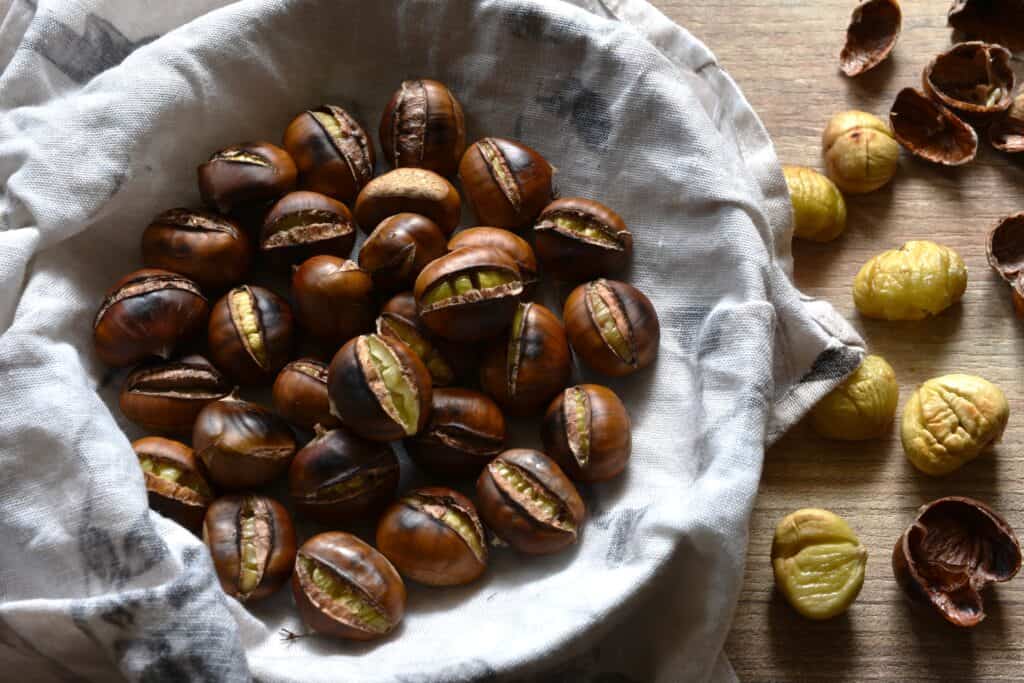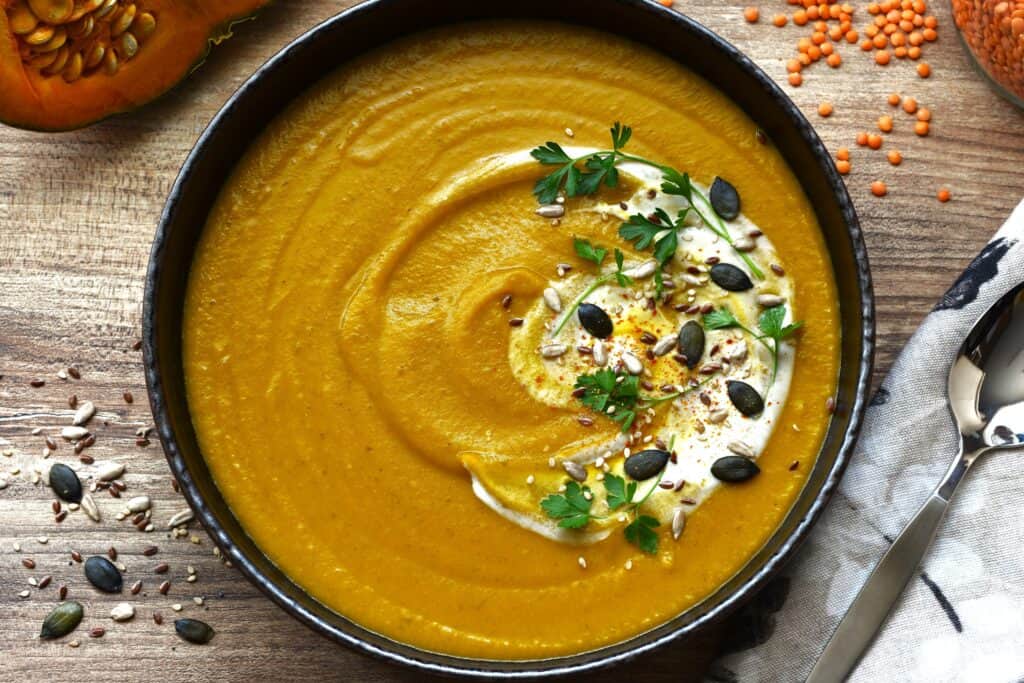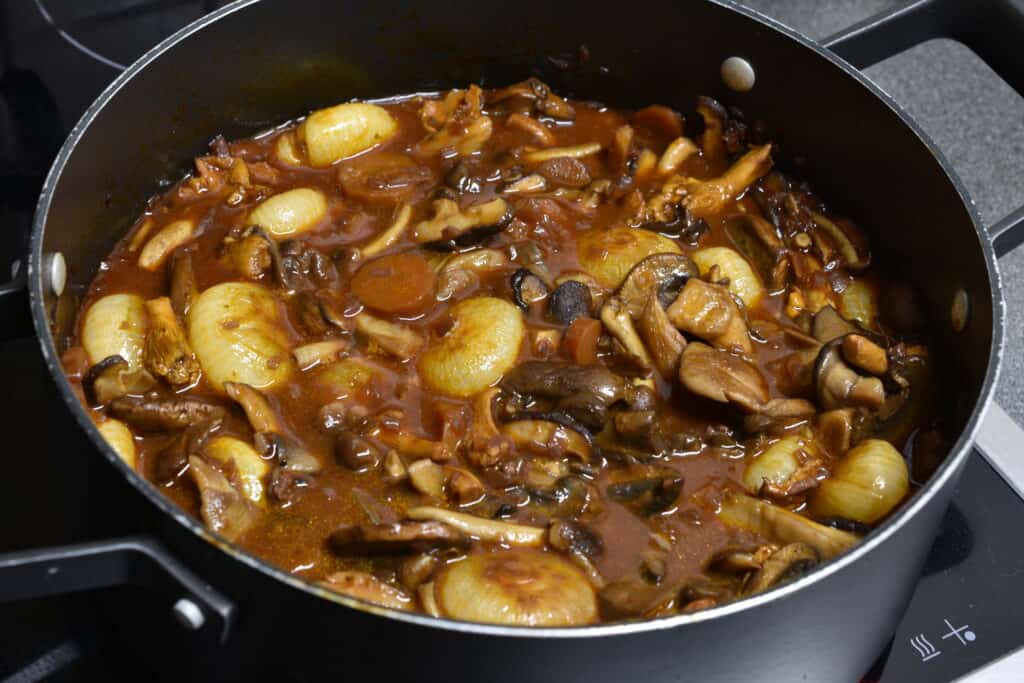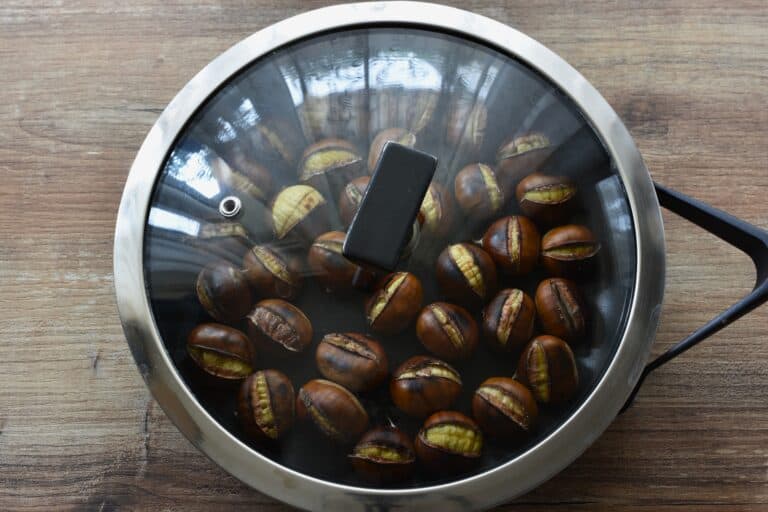Perfect pan-roasted chestnuts are easy to peel, lightly charred on the outside with an irresistible smoky flavour, but moist and buttery on the inside! Roasting chestnuts is a timeless tradition that captures the essence of autumn. There’s something warm and comforting about sitting around a pan of chestnuts with your loved ones. They’re an iconic symbol of the season, cherished for their earthy, nutty flavour and creamy texture.

These pan-roasted chestnuts are quick and easy to make without any special equipment. In this blog post, I’ll let you in on all the little secrets on how to get perfect pan-roasted chestnuts. No disappointments, I promise! You’ll learn all the tips and tricks, from what equipment you’ll need, to how to score them, whether they should be soaked or not, and how to cook them. Slightly crispy on the outside, and moist and buttery on the inside. And, of course, a breeze to peel!

Not so long ago, people survived in the region where I now live, thanks to chestnuts. A hundred years or so ago, Ticino was a very poor area, and people had very little to eat. Chestnuts provided an essential food source for them. Today, poverty is no longer an issue here, but the tradition of transforming chestnuts into mouthwatering little morsels to share with good friends lives on.
What is a serving size of pan-roasted chestnuts?
Calculate between 80 and 100 g per person. That will be approximately 15 chestnuts per person or around 10 if they’re served with other food or as a snack (see serving suggestions at the end of this post). Chestnuts are surprisingly filling and nutritious.
Nutritional value of chestnuts
Chestnuts are packed with a variety of nutrients. They are low in calories because they contain very little fat. Chestnuts are a good source of fibre as well as numerous vitamins and minerals.
Vitamins
- Vitamin C
- Vitamin B6 (Pyridoxine)
- Folate (Vitamin B9)
- Niacin (Vitamin B3)
- Riboflavin (Vitamin B2)
- Thiamin (Vitamin B1)
- Pantothenic Acid (Vitamin B5)
Minerals
- Potassium
- Phosphorus
- Magnesium
- Calcium
- Iron
- Zinc
- Copper
Tips and tricks for perfect pan-roasted chestnuts
Equipment
All you need is a standard non-stick frying pan or a cast iron pan. Don’t bother with the special chestnut pan with the holes in it because you’ll get perfect results in a normal pan, without the mess that those holes leave on your cooker! Your chestnuts should fit in a single layer in the pan. A pair of tongs could be useful for turning them, but not essential – a spoon and fork will do. You’ll also need a small sharp knife, preferably with a serrated edge, for scoring.

How to choose the right chestnuts
I once stumbled on a chestnut gold mine while I was out in the woods looking for mushrooms. I was exploring, so I didn’t know the area. It turned out it wasn’t that great for mushrooms, but the chestnuts… they were the biggest, shiniest, most beautiful chestnuts I had ever seen! And there were tons of them. It’s my regular spot now, and every autumn I go and get a big bagful.
Chestnuts should be shiny, dark brown and firm. Older chestnuts are dull and tend to become lighter in colour. You can cook them anyway, but if you have the choice, go for the freshest you can find. When you squeeze a chestnut, ideally, it should be firm.

Sometimes you can feel a little space between the outer shell and the chestnut inside. These are chestnuts that have dried out a bit. As long as the empty space isn’t too big, they should be okay. No space is better, though. Chestnuts that have dried out a bit are best boiled rather than roasted because they rehydrate somewhat while they are cooking.
Check your chestnuts for holes
Give your chestnuts the once over. Check for little holes and discard any that have one. The holes are made by Chestnut weevils. Adult females drill holes in the chestnut bur and insert eggs into the cavity. After the eggs hatch, the larvae feed on the chestnut inside. The entry holes are tiny, the exit holes are much larger. Little piles of what looks like fine sand among your chestnuts are a telltale sign that there are weevils about. Don’t bin the lot – just check them over thoroughly – you’ll soon find the ones you need to throw out.
How to score chestnuts for pan-roasting
Score your chestnuts with a sharp knife on the rounded side. Without scoring, the chestnuts would explode during cooking. I find a serrated knife is best for this job. Most chestnuts, but not all, have a rounded side and a flat side. Some have two flat sides. They are the ones that were in the middle. There are usually three chestnuts in a cupule, also called a bur or burr (outer spiny shell). End nuts have one flat face and a broad rounded side, whereas middle nuts have two flat sides.
The cut should be deep enough to cut through the pellicle as well as the shell. Cut them horizontally, all the way across, from ear to ear, so to speak. The wider the cut, the easier they will be to peel. I hold the chestnut up in one hand and make the incision with the other hand. Some people feel more comfortable laying them flat on a chopping board to score them.

Soak the chestnuts
Put the chestnuts in a bowl of water and leave them to soak for 20 minutes. When chestnuts are soaked, the moisture inside them turns to steam during cooking, helping them cook through more uniformly. Soaking also contributes to the overall flavour and texture. The chestnuts are less likely to become dry or mealy when soaked before roasting. Soaking helps to loosen the inner membrane (pellicle) that separates the nut from the shell. This makes peeling the chestnuts much easier, which is essential for a hassle-free eating experience. Chestnuts can be difficult to peel without soaking.

How to get perfect pan-roasted chestnuts
Drain the chestnuts and place them, still wet, in the pan with the cut side down. Turn on the heat to medium and put a lid on the pan. That way, the chestnuts will steam cook for the first 10 minutes or so, making them deliciously moist inside before being roasted and lightly charred on the outside. I have a glass-ceramic hob and I use heat setting number 5. I cook the chestnuts with the lid on, and without turning or tossing them at all, for about 8 to 10 minutes. How long you will need to cook them may vary depending on the kind of cooker you have and how big the chestnuts are.
After 5 to 6 minutes, lift the lid and turn a chestnut over to see how they are doing. You’ll probably need to put the lid back on and cook them a bit longer. They are done on that side when the slit has opened up and they have started to brown. At this point, turn all the chestnuts over one by one, using tongs or a spoon and fork. By now, most of the moisture will have evaporated. Put the lid back on and turn the heat down to setting 3 for 3 minutes, and then right down to setting 1 for another 4 or 5 minutes, or until the chestnuts are cooked through. The skin should be well browned and a bit burnt in places, but not carbonised!

How to sweat the chestnuts after roasting
When the chestnuts are done, put them inside a very damp cloth.

This is called “sweating” them, and it makes them easier to peel. Placing them in a damp cloth after roasting helps to restore some of the lost moisture and stops the chestnuts from drying out too much. Don’t leave them to stand, though. The damp cloth trick is only for the chestnuts that you are not actually eating. You should start peeling and eating the chestnuts as soon as they come out of the pan! Discard any that aren’t cream-coloured to pale yellow inside. Bin any with dark patches or that are dark beige to brown in colour. They are either old or could have larvae inside.

Once chestnuts go cold, they will become difficult to peel again. If this happens, just pop them back in the pan to heat them up again! When hot, the shells should come off quite easily.
Serving suggestions
Roasting chestnuts is a social occasion, so invite your friends around and open a bottle of red wine!
For a complete, heartwarming autumn meal, you could pair roasted chestnuts with pumpkin and red lentil soup, or roasted pumpkin slices with rosemary and thyme or smoked paprika.
How to store pan-roasted chestnuts
It’s better to only roast the chestnuts that you’re going to eat immediately. Once roasted, they don’t keep very well. If you don’t finish them all, leave them in the damp cloth. When you’re ready to polish them off, heat them up again in the pan. They should peel quite easily.

How to store raw chestnuts
Store raw chestnuts in a cool place with good air circulation. You can keep them like this for perhaps a week or more, depending on the ambient conditions. Mould tends to form if there’s too much humidity, and they’ll soon dry out if it’s very dry. The best thing to do is preserve your chestnuts by freezing, vacuum packing, canning or drying. Freezing is by far the easiest method.
I hope you enjoy your pan-roasted chestnuts and that they turn out like the photos above (or better)! If you found this post helpful, it would be great if you could give it a star rating and leave a comment below! It helps other readers find my content and posts and ultimately makes my blog more successful! Thanks so much for your support! Deborah xx
While you’re here on Vegan Hot Stuff, maybe you’d like to take a look at some other popular autumn dishes…






Would you like to receive my recipes as soon as I publish them? Subscribe below!









Fantastiche!!!
Una ricetta veramente molto dettagliata e se seguita bene, si gustano delle castagne eccellenti dal sapore e dalla consistenza unica.
Consigliatissime
Sì, è vero! Una volta che sai i piccoli trucchi e segreti, escono sempre perfetti. Grazie per la recensione!